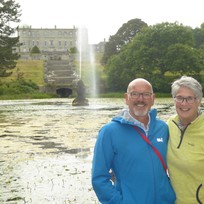( Overview
/ Two Scilly Bullocks on a Boat
A wooden cross has stood at the entrance to Fowey Harbour since 1525. Punches Cross may have been a boundary mark, or perhaps it’s where Joseph of Arimathea, who was in the tin trade, and Jesus landed. Or was it Pontius Pilate that came or that the Monk who collected the harbour dues lived in Pont?
As we left Fowey with a number of other yachts (we’ve never had so much company), the day was calm and sunny. Dolphins or Harbour Porpoise also regularly swam past.
We sailed past Polperro and Looe. Holidaying in Cornwall as a child, Kevin remembers the fishermen dragging sharks up the street from the harbour in Looe to be hung up and weighed.
Rame Head was owned by Tavistock Abbey in the 10th century, so although geographically in Cornwall, the land once belonged to Devon.
Dating from before the 14th century, Rame Head Chapel is dedicated to the Archangel St Michael. It has been used as a lookout and watchtower as well as a place of worship.
We’re not used to so much marine traffic. We had to take evasive action as RFA Stirling Castle wasn’t going to detour from its course. It’s an offshore forward operating base, deploying Mine Countermeasure Systems, drones and crewless systems to find and neutralise sea mines and seabed threats.
Great Mewstone at the entrance to the River Yealm. Mewstone is the old English name for the herring gul. These, and other birds, including cormorants and shags, are the only inhabitants nowadays. Owned by the National Trust, there is no public access.
Looking across Little Mewstone to the abandoned house, and then there are more rocks, the Outer Slimers…
The entrance into the river has a sand bar. Red buoys mark the passage in, which is very close to the starboard shore.
As we weaved our way through the moored boats, many 2 at a time on the mooring buoys, and rafted onto the pontoons, we doubted whether we’d find anywhere to stop, especially as anchoring is forbidden in most of the river.
Almost deciding we should head for one of the marinas in Plymouth, we finally passed the harbour master’s boat (we hadn’t been able to contact him by radio or phone) and asked him whether there was somewhere for us, especially as we can be shallow draft.
He sent us up the river, almost to the end of the navigable part, to the Kitley Estate private moorings. We think we might have got the last available buoy.































 Sign in with Apple
Sign in with Apple  Log in with Facebook
Log in with Facebook